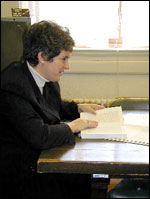|
|
||
Dionysios Solomos was born on the island of Zakinthos, (Zante) in 1780. His father, the aristocrat Count Nikolaos Solomos, known as "Conte-Tobacco" because he controlled the tobacco monopoly, married Dionysios' mother, the young and beautiful maid of Solomos, Angeliki Necles, only one day before his death, in 1807. The Solomos family was an aristocratic family of Venice with branches on the island of Crete, remaining there until the Turks conquered the island in 1669. When Conte - Solomos passed away, young Dionysios was sent to Italy to study. There the young boy studied Latin and Italian philology and wrote Italian and Latin verses that greatly impressed his schoolmasters. One of his teachers once exclaimed: "Greek, you will cause our Monti to be forgotten." In 1815 the young Solomos graduated from the Cremona High School and entered the Law School of the University of Padua, where the children of most of the Ionian Islands' aristocracy studied. Solomos, leaving Italy in 1818, returned to his native Zante. He had completed his law studies, though not very successfully, but during his stay in Italy he became acquainted not only with Italian literature but also with Classical Greek and Latin literature.
Solomos and Tricoupis discussed the Hellenic War of Independence quite extensively. His poem "Hymn to Liberty", which he wrote in 1823, is a result of these discussions. The first two stanzas of the poem, with music by his close friend Nicolaos Mantzaros, became the national anthem of Greece in 1864, replacing the Greek translation of the Bavarian National Anthem, which had been used until that time. The poem consists of 158 stanzas of rhymed eight and seven and eight-syllable trochaic verses, was written in about one month in the spring of 1823. The trochaic meter used by Solomos, intensifies the image he captures - Freedom as a young woman rushing through the land. In the two first stanzas the poet addresses and greets Freedom who is dwelling in a tomb, with words she never heard before. In stanzas 3-16 Freedom appears sad, because she is driven out from her home, Hellas. Even though people are not concerned with her fate she endures and hopes that some time her home will be glorious again. When she asks for help knocking on doors, she suffers false promises that turn into sarcastic remarks and she frantically returns to her tomb. Stanzas 17-34 show the change of the Hellenes as they realize that the time has come to liberate their country, which they achieve after many efforts. They announce the happy news to Freedom. England is surprised by and suspicious of this sudden change and the Turks behave frantically, realizing this is the end for them. The "brave" Hellenic cities frighten away the enemy who is still trying to overpower Hellas. The Hellenes however don't give up and at the end of the poem (stanzas 137-158) Freedom is invited back to her homeland and everyone is ready to welcome her and to honor her as before. A lot of people have tried to translate the first stanzas of this poem into English, but none has succeeded in rendering the splendor of the images and the rhythm of the original satisfactorily, because it is a very complicated poem to translate. More |
||


